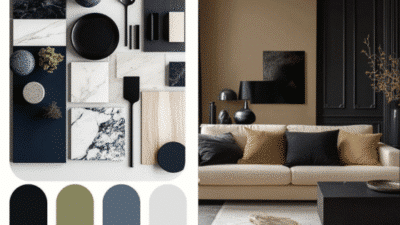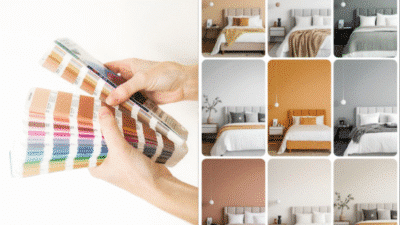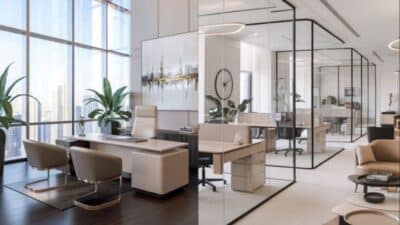Why Texture Matters More Than Ever
Neutral rooms have dominated design feeds for years, but perfectly smooth walls and tone‑on‑tone palettes can feel flat. The 2025 remedy is texture: ribbed tile, nubby bouclé, and softly clouded limewash—quiet details that invite touch while letting your favourite creams and greiges stay put. Ahead are six quick upgrades, from a weekend paint trick to slimline wainscoting, each designed to give neutral spaces fresh dimension without a full colour overhaul.
Soft Layers: Bouclé & Plush Textiles
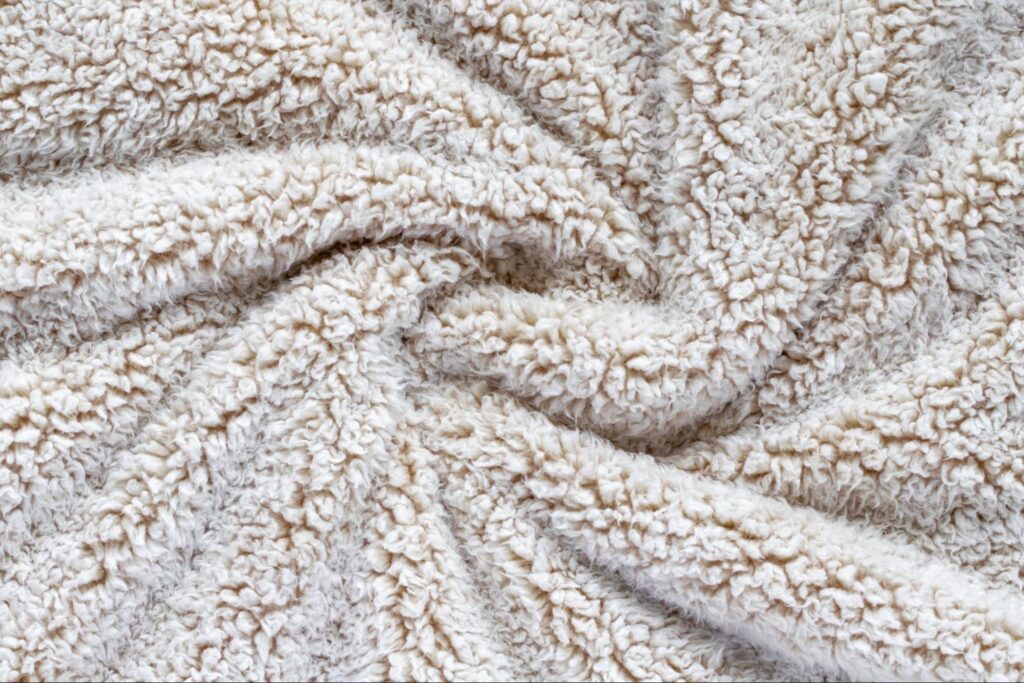
There’s a reason bouclé sofas and teddy‑bear throws have taken over design feeds: their gentle loops and napped surfaces catch light differently than flat cotton, casting tiny shadows that read as warmth. (Need proof? Check Sky Rye’s own cozy‑living‑room checklist where a sherpa blanket tops the must‑have list.) In a neutral room, that shadow play is precious real estate; it keeps creams from looking clinical and greiges from going gray.
What sets the 2025 look apart
- Bigger loops, lower sheen. Manufacturers are spinning bouclé with chunkier yarns and matte finishes, giving upholstery a cloud‑like profile that hides everyday wrinkles.
- Sherpa spill‑over. Once limited to accent pillows, deep‑pile sherpa is migrating to oversized headboards and wall‑hung panels that double as sound dampening.
- Blended sustainability. Recycled‑poly bouclé now rivals virgin wool in softness, so you don’t have to choose between touchable texture and eco‑cred.
Design moves to try
- Anchor with a statement seat. Re‑cover a tired club chair in mushroom‑tone bouclé; the curved arms and tactile fabric will draw the eye without shouting.
- Layer at three levels. Think floor (shag area rug), mid‑height (sofa or bench), and eye‑line (oversized lumbar cushion). Repeating plushness at varying heights makes the texture feel intentional—see how Sky Rye blends textures in their guide to stylish living‑room décor.
- Dial up depth with tonal contrast. Pair ivory bouclé against a slightly darker linen curtain. The near‑tone shift is subtle yet enough to reveal the loops.
Pro tip: Before upholstering, run a fabric brush across the sample; loose loops that snag easily will pill later. Look for a rub count of 30 000+ for seating pieces.
Budget‑savvy swap
Can’t spring for a new sofa? Slipcover a footstool in off‑cut bouclé, then echo that texture with a matching throw on your existing couch.
Why it works
Plush textiles trap and bounce light, creating micro‑highlights that give flat neutrals a living, breathing quality — the very essence of this year’s texture‑over‑color philosophy.
- What’s new: updated bouclé in oat & mushroom hues; teddy‑wool throws.
- Styling tips: mix pile heights; contrast matte linen with dense bouclé.
- Quick‑win ideas: swap pillow covers, drape a sherpa bench cushion.
Vertical Lines: Ribbed & Slatted Wood
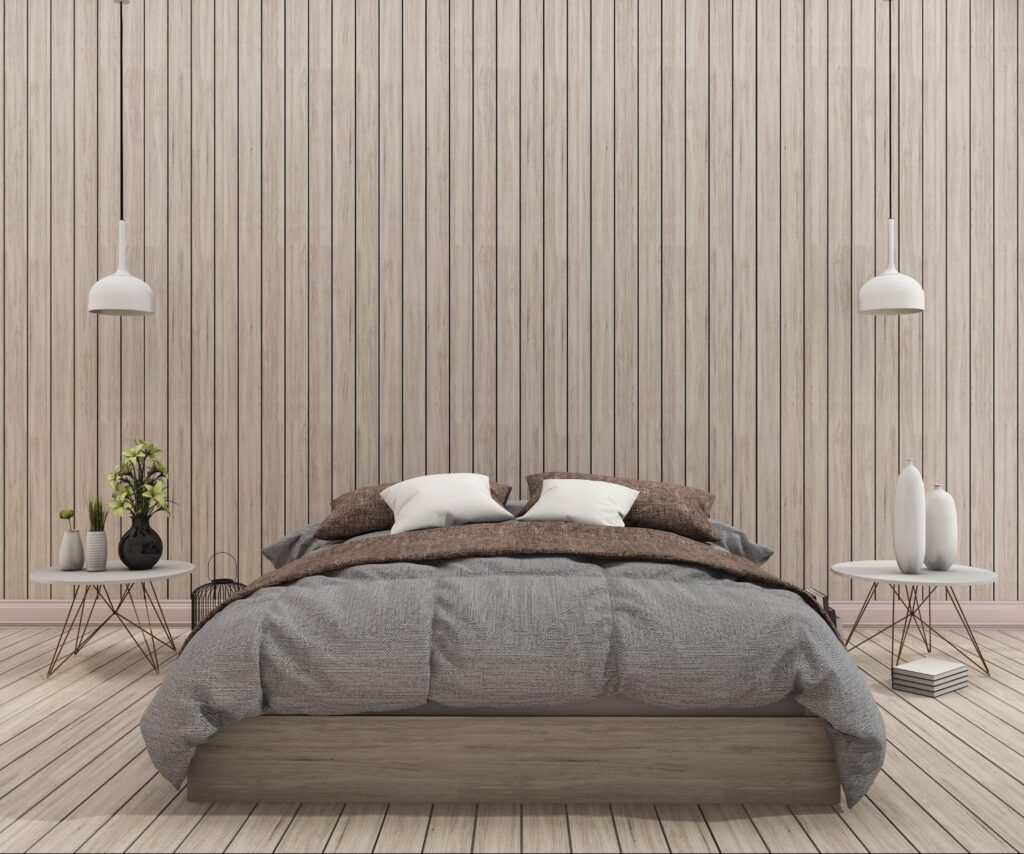
Picture the ripples left on sand after a gentle tide recedes; ribbed and slatted panels bring that same quiet rhythm to a wall. By running texture top‑to‑bottom, they naturally draw the eye upward, a gift in rooms where the ceiling height feels a little shy.
Why designers are leaning in
- Subtle depth without bulk – Thin fluting (10–20 mm) creates enough shadow to read as dimension yet keeps profiles slim for hallways or small condos.
- Easy acoustics boost – Narrow grooves scatter sound waves, softening echo in open‑plan spaces without heavy fabrics.
- Material flexibility – Timber veneer for a Nordic vibe, coloured MDF for budget builds, even recycled PET felt slats for an eco‑quiet statement.
Spec & style tips
- Mind the repeat. A 25 mm rib + 10 mm valley is a sweet spot: visible from across the room but not so chunky it overpowers millwork.
- Stain, don’t paint (most of the time). A translucent oil shows off grain, letting light skim across peaks. If a painted look is non‑negotiable, spray‑finish after installation to avoid brush lines pooling in the channels.
- Break at chair‑rail height if the ceiling is under 8 ft. The horizontal trim offers the eye a rest and prevents the “wood elevator shaft” effect.
DIY hint: Pre‑backed slat panels mount like a giant picture frame. Find the studs, pop six screws, and you’re done—no painstaking batten spacing.
Room inspiration
- Entry vestibule – One narrow slatted wall behind a console gives instant architecture where drywall once felt blank.
- Bedroom headboard zone – Take the fluting all the way across the wall, then float nightstands against it so drawers appear embedded.
- Ceiling treatment – Align slats perpendicular to the longest wall to visually widen a skinny room.
Timeless Paneling: Subtle Wainscoting for Modern Spaces
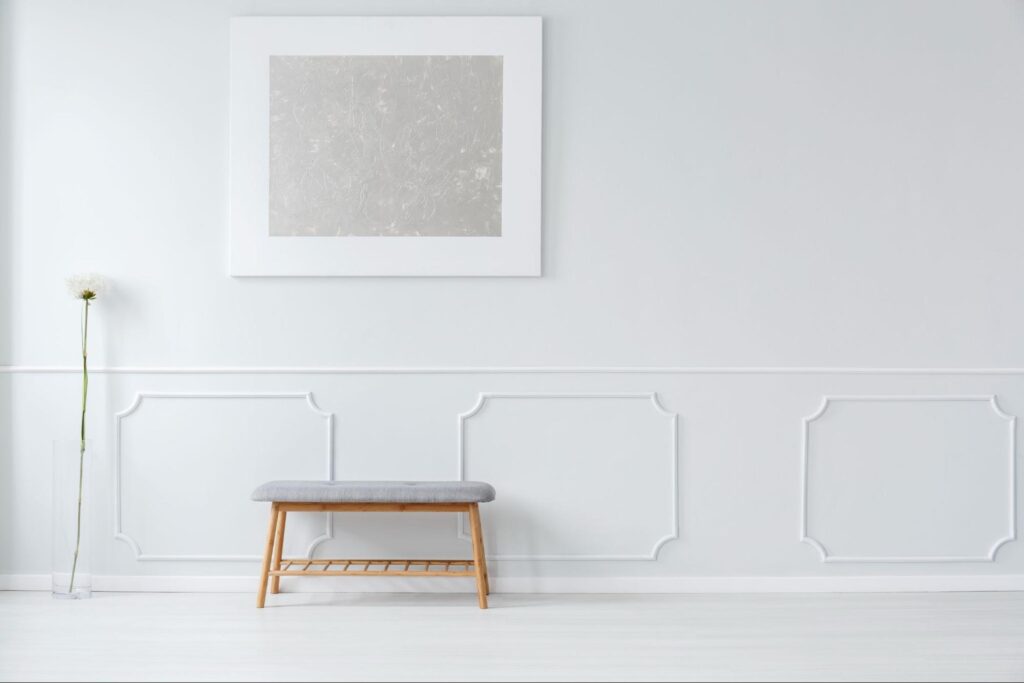
Interior trim doesn’t have to shout to make an impact. The newest wave of wainscoting swaps ornate Victorian profiles for line‑driven panels just ½‑inch deep, creating a refined shadow line rather than a bulky statement. Think of it as quiet architecture: it frames furniture, softens wall expanses, and adds tactile interest that a flat coat of paint can’t achieve.
Modern takes we’re seeing:
- Micro‑Shaker rails – Narrow stiles and rails (under 2 inches) keep sight‑lines crisp while still giving walls a crafted look.
- Full‑height interpretations – Instead of stopping at chair‑rail level, some designers are running slim panels all the way to the ceiling, then colour‑matching trim and wall paint for a monolithic feel.
- Shadow‑gap reveals – A 3 mm recessed groove between panel edge and baseboard replaces traditional quarter‑round, adding a minimalist detail that collects light, not dust.
Designer tip: Pair low‑profile wainscoting with the ribbed‑wood trend from the previous section; the gentle collision of horizontal panel breaks and vertical slats creates a sophisticated, gallery‑like grid.
Material & finish play
| Option | Look & feel | Eco / budget notes |
| FSC‑certified solid poplar | Knocks‑proof, accepts stain or paint | Higher cost; durable for busy hallways |
| Smooth‑face MDF | Seamless once painted; no grain distractions | Recyclable content available; best for super‑flat walls |
| Limewashed plywood | Visible grain beneath a chalky film | Lower VOC; works in Scandinavian schemes |
Need visuals before you commit? Here’s a room‑by‑room styling guide that showcases modern wainscoting in action — from understated dining rooms to cozy entryways.
Why it earns its keep in neutral rooms
- Light choreography – Even shallow panels catch sunlight at different angles, adding depth without resorting to colour.
- Visual zoning – A mid‑height rail naturally delineates seating nooks or reading corners in open‑plan spaces.
- Heritage without heaviness – The detail nods to traditional craftsmanship while staying firmly in the 2025 aesthetic: subdued, sustainable, and tactile.
In spaces awash with oatmeal paints and stone flooring, subtle panelling acts like a linen blazer over a monochrome outfit: it lifts everything, yet never upstages the calm beneath.
Sculpted Surfaces: Fluted Plaster & 3‑D Tiles
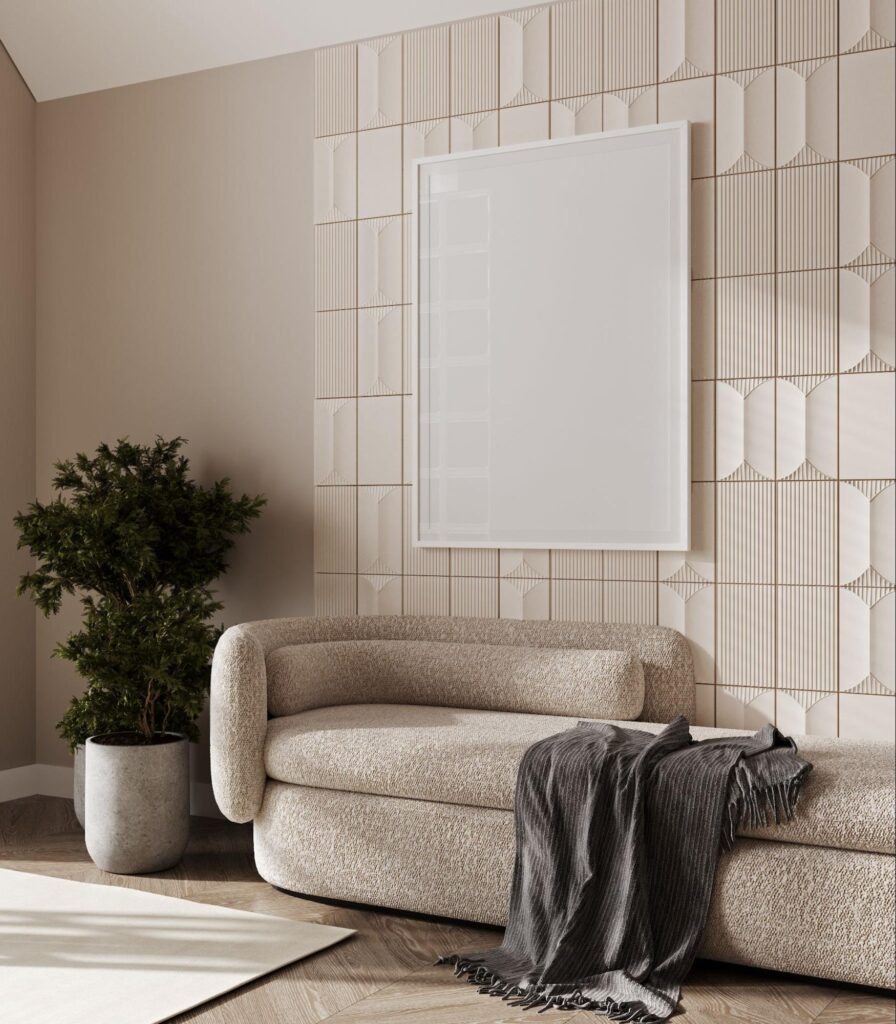
At first glance a matte‑white wall feels quiet, but run a soft raking light across fluted plaster and it suddenly behaves like fabric—peaks catch the glow while valleys fall into shade. That play of highlight and lowlight is what makes sculpted finishes the breakout star of 2025.
Why this texture speaks to neutral interiors
- Light choreography – Deep ribs (8–12 mm) or convex tile modules scatter illumination much like pleated linen, adding life without adding colour.
- Seam‑free modernism – Cast‑in‑place plaster or large‑format gypsum panels eliminate grout lines, creating a continuous wave that feels more art installation than wall treatment.
- Mindful materiality – Lime‑based plasters regulate humidity and absorb VOCs; porcelain and recycled‑glass 3‑D tiles offer low‑emission alternatives.
Where designers are using it
- Niche backsplashes – A single run behind the kitchen hob gives utilitarian space a sculptural moment.
- Fireplace surrounds – Fluted plaster “mantels” read as custom stonework for a fraction of the weight.
- Headboard walls – Shallow relief tiles behind the bed create a tactile focal point that invites soft, indirect lighting.
Pro tip
Keep profiles shallow (under ½‑inch) in tight corridors so the relief doesn’t encroach on walkways. Pair with low‑wattage strip lights to accentuate shadows after dark.
Finish ideas
- Bone white + satin sealer for a gallery vibe.
- Warm clay wash over lime plaster for soft, dusty tones.
- Matte black ceramic modules when you want the texture to read first, colour second.
Cost & install snapshot
| System | Average installed cost (USD) | Lead time | Maintenance |
| Fluted lime plaster (troweled) | $14–18 / sq ft | 4–6 weeks (custom) | Wipe with damp cloth; re‑seal every 5 yrs |
| Pre‑cast gypsum panels | $9–12 / sq ft | Stock: 1 week | Paintable, low‑dust |
| 3‑D porcelain tiles | $7–15 / sq ft | Stock: 3–5 days | Standard tile care |
Bring it together
For rooms already draped in creams and stone greys, sculpted surfaces supply the missing rhythm that textiles alone can’t achieve. They stay tonal—letting your neutral palette breathe—yet command enough character to stand in for artwork when wall space is limited.
Organic Coats: Limewash, Clay Paint & Micro‑Cement
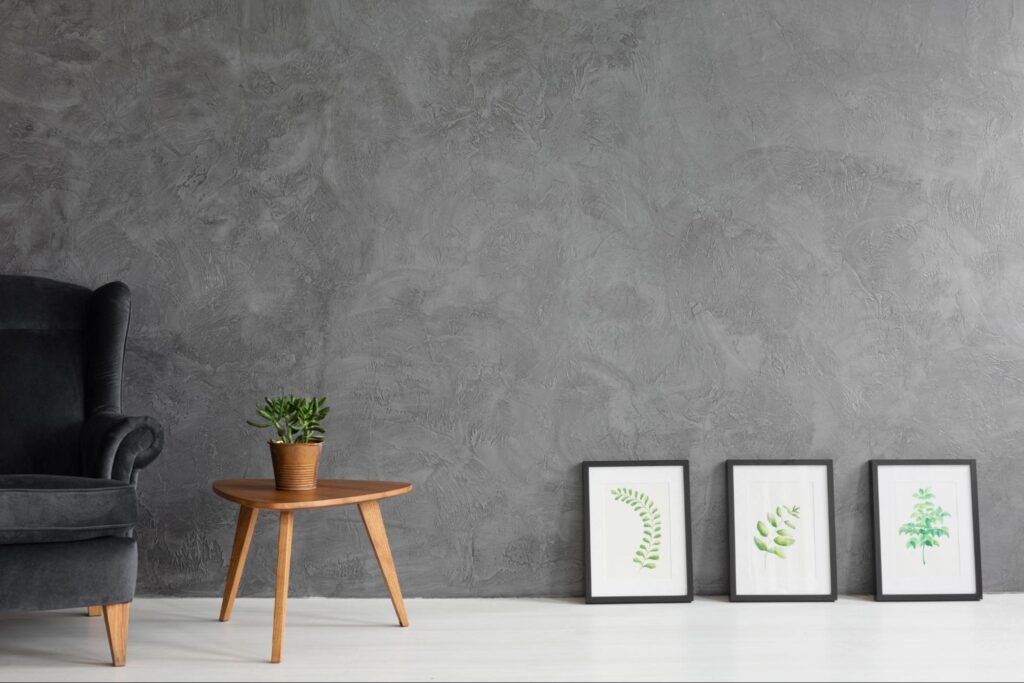
Sometimes texture is less about adding a layer and more about letting the wall itself breathe. That’s the appeal of mineral‑rich finishes—they create subtle movement without extra material build‑up.
Limewash’s cloud effect
- Made from slaked lime and natural pigments, limewash dries with tonal variations that mimic watercolor.
- Because it calcifies to the substrate, the finish gains depth over time rather than fading.
- Best for: bedrooms and reading nooks where you want a cocooning softness.
Clay paint for a velvety matte
- Composed of earthen clays, chalk, and casein binders, clay paint absorbs light for a suede‑like glow.
- Naturally regulates humidity—handy in climates with seasonal swings.
- Tip: Apply with a rounded brush in overlapping strokes to exaggerate the hand‑troweled look.
Micro‑cement’s seamless skin
- A fine cement‑based coating troweled just 2–3 mm thick over drywall, plaster, or tile.
- Creates continuous surfaces across walls, floors, and even shower stalls—no grout lines to interrupt the eye.
- For neutral palettes, the light grey variant reads as architectural yet understated.
Specification snapshot
| Finish | Average cost (DIY) | Sheen | Key benefit |
| Limewash | $1.50–$2 / sq ft | Chalk‑matte | Breathable & patina‑friendly |
| Clay paint | $2–$3 / sq ft | Ultra‑matte | VOC‑free humidity buffer |
| Micro‑cement | $7–$9 / sq ft | Satin‑matte | Seamless, water‑resistant skin |
Styling takeaway
Pair mineral coats with tactile accessories—linen sheers, unglazed ceramics—to keep the narrative cohesive. The finish should feel like part of the wall’s DNA, not a decorative afterthought.
Mixed‑Material Mash‑Ups
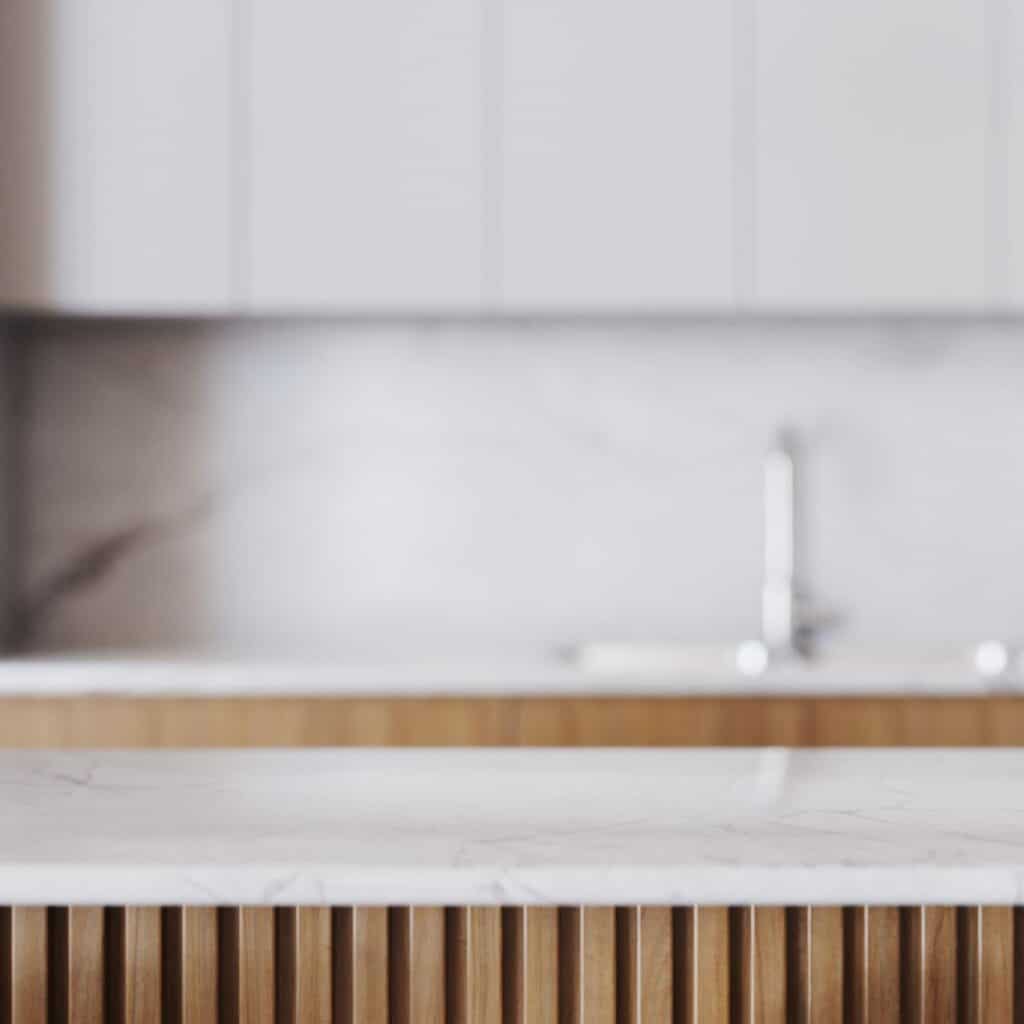
A single texture can calm a room; layered textures create stories. In 2025, designers are purposely colliding contrasting surfaces—think ribbed oak meeting honed marble or micro‑cement framed by a brushed‑brass reveal—to keep neutral schemes engaging from every angle.
How to blend without clutter
- Rule of three – Anchor the space with one dominant texture (for example, a limewashed wall), add a supportive secondary finish (such as slim wood slats on built‑ins), then fold in an accent (maybe a touch of patinated metal). This hierarchy keeps the eye from bouncing around.
- Match undertones, not colors – If your palette skews warm, choose materials that share a golden base (walnut, alabaster, unlacquered brass). Cooler undertones pair easily with dove gray plaster, stainless, and river stone.
- Play with scale – A broad, low‑relief wainscot pairs beautifully with a micro mosaic backsplash because the difference in pattern size prevents competition.
Designer micro‑tip: When combining wood slats and panel molding, align the slat spacing with the centerlines of the panels below. The subtle echo reads as intentional, not busy.
Quick mash‑up ideas to try
- Wainscoted breakfast nook + cane‑webbing bench – The smooth painted panels let the open weave shine while still protecting the wall. For inspiration, see the practical room‑by‑room guide here.¹
- Fluted plaster chimney + matte‑stone hearth – Vertical ridges draw the eye up; the hearth’s subtle grit grounds the vignette.
- Micro‑cement vanity + ribbed‑glass doors – Both finishes are low sheen, yet their differing hand‑feel delivers depth.
Why it works
- Layering textures mimics nature—tree bark beside water beside rough rock—so our brains instantly read the room as welcoming.
- Mixes stretch budgets; adding a single accent material can refresh an entire plain space without new furniture.
Texture is no longer a supporting actor. By orchestrating thoughtful mash‑ups, you can turn the quiet neutrality of 2025 interiors into a tactile narrative that unfolds as you move through the home.
Budget & DIY vs. Pro Cheat Sheet
Before you grab a sample pot or call a contractor, or even loop in a staging team for a fast market-ready refresh, weigh three quick factors for each texture: material cost, skill demand, and hidden extras (prep, tools, curing time). Use the notes below as a reality check, not a rule‑book — regional prices and your tool stash will shift the math.
| Texture move | DIY‑friendliness | Ballpark cost (USD / sq ft) |
| Bouclé & plush upholstery | ★★★☆☆ | |
| Staple gun + fabric glue for small pieces; re‑covering a full sofa is best left to a pro upholsterer. | $12–$25 (fabric) | |
| $45+ pro labour per hour | Measure twice, trim once — fabric stretches. Scotchgard light tones. | |
| Ribbed / slatted wood | ★★☆☆☆ | |
| Pre‑made MDF slat panels are weekend‑friendly; custom oak fluting needs table‑saw precision. | $4–$9 MDF | |
| $12–$18 oak | Prime cut edges, allow for expansion gaps. Hire a finish carpenter for curved walls. | |
| Subtle wainscoting | ★★☆☆☆ | |
| Recessed MDF kits install with brad nailer + caulk; complex profiles or stair runs go pro. | ||
| Need room‑by‑room inspo? See the practical guide referenced earlier. | $3–$7 MDF | |
| $10–$15 poplar | Level first board, check outlet clearance. Paint after caulk fully cures. | |
| Fluted plaster / 3‑D tiles | ★☆☆☆☆ | |
| Plaster fluting demands steady trowel work; hire a plasterer. 3‑D tiles are DIY with patience. | $8–$14 plaster | |
| $6–$10 tile | Weight adds up — verify wall studs; seal plaster to avoid dusting. | |
| Limewash / clay paint | ★★★★☆ | |
| Requires wide brush + criss‑cross strokes; forgiving and fun. | $1.50–$4 (two coats) | Colour shifts as it dries; test a 2×2 patch first. |
| Micro‑cement | ★☆☆☆☆ | |
| Multi‑coat, needs burnishing and sealer; pay the pro. | $7–$12 | Moisture‑tolerant but needs 7‑day cure before heavy use. |
| Mixed‑material combos | Varies | |
| Often means coordinating trades. Tackle one layer yourself, sub out the rest. | Add 10–15% contingency | Sequence matters — let the dustiest trade go first. |
Quick takeaway: If a finish requires a trowel, torch, or table saw you don’t own, the savings often vanish. For everything else, a Saturday, a level, and good caulk go a surprisingly long way.
Conclusion — Let Neutrals Speak in Stereo
A neutral palette doesn’t have to whisper. By layering soft bouclé curves, disciplined vertical lines, timeless wainscoting shadows, and sculpted mineral surfaces, you give beige and ivory something they rarely get on their own: dimension you can feel.
Start small—swap a flat cotton throw for a looped one, limewash a single accent wall, or add thin‑profile panels along an entryway niche. Texture rewards these incremental moves; each new surface changes how daylight travels through a room, letting the space evolve throughout the day.
Use the cheat sheet above as your field guide, keep an eye on scale, and trust your fingertips as much as your eyes. When texture does the heavy lifting, colour can keep its gentle hush while the room still hums with life.
–––
Have you tried any of these texture trends? Share your photos with the Sky Rye community—your experiment might be the spark for someone else’s design story.
Author Bio
Melody Stevens is the founder and CEO of Design on a Dime Interiors in Conroe, TX. With a decade of transforming “so-so” spaces into show-stoppers, she blends budget-smart hacks with a designer’s eye for soul-warming detail. When she’s not pinning her next wainscoting obsession, you’ll find her chasing sunlight for the perfect before-and-after shot—or cheering clients on as they fall back in love with their homes.
- 0shares
- Facebook0
- Pinterest0
- Twitter0

